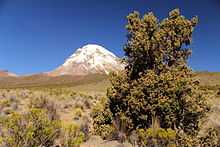Polylepis tarapacana
From Wikipedia, the free encyclopedia
| Polylepis tarapacana | |
|---|---|
 | |
| Conservation status | |
| Scientific classification | |
| Kingdom: | Plantae |
| (unranked): | Angiosperms |
| (unranked): | Eudicots |
| (unranked): | Rosids |
| Order: | Rosales |
| Family: | Rosaceae |
| Genus: | Polylepis |
| Species: | P. tarapacana |
| Binomial name | |
| Polylepis tarapacana Phil. [2] | |
Polylepis tarapacana, known in its native habitat by the Spanish common name Queñoa De Altura[1] (polylepis or quenoa of [high] altitude), is a short tree or shrub which is found in small, scattered groupings along the mountainous borders of Bolivia, Chile, and Peru (Western Cordillera),[1] growing in soil formed by volcanos.[1] Populations may also be present in Argentina, but this is unconfirmed.[1]
Source
- ↑ 1.0 1.1 1.2 1.3 1.4 Assessor: World Conservation Monitoring Centre (1998). "Polylepis tarapacana in IUCN 2011". IUCN Red List of Threatened Species. Version 2011.1. International Union for Conservation of Nature and Natural Resources. Retrieved July 28, 2011. "Lower Risk/near threatened ; Needs updating"
- ↑ Polylepis tarapacana was first described and published in Anales del Museo Nacional de Chile. Segunda Sección — Botánica. 8: 21. 1891. "Name - Polylepis tarapacana Phil.". Tropicos. Saint Louis, Missouri: Missouri Botanical Garden. Retrieved July 28, 2011.
This article is issued from Wikipedia. The text is available under the Creative Commons Attribution/Share Alike; additional terms may apply for the media files.
